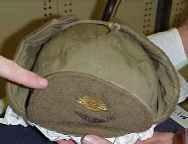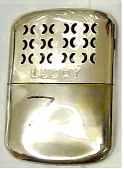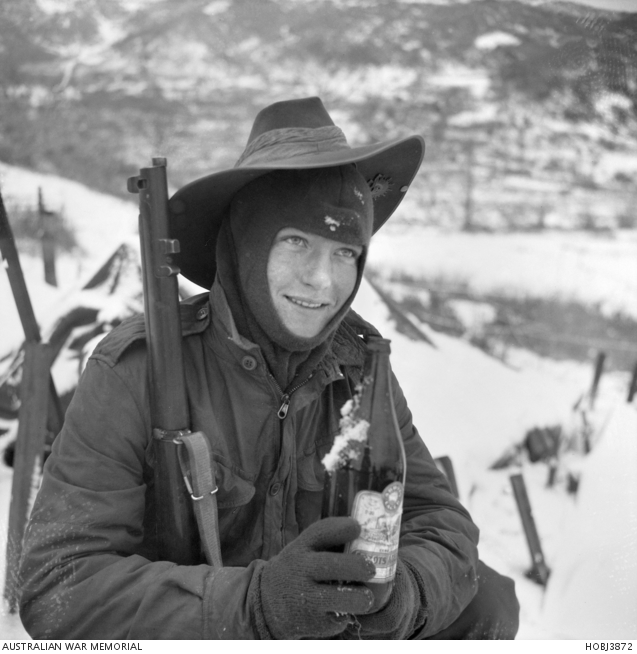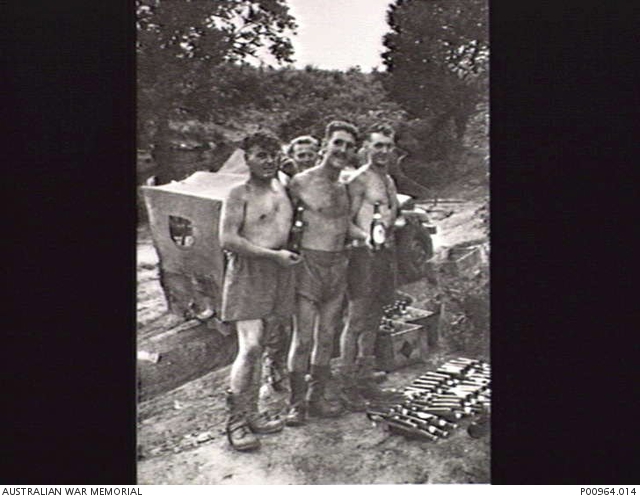Out in the Cold: Australia's involvement in the Korean War - War on land: the Australian Army in Korea
“The Korean War was overwhelmingly a land war, in terms of numbers of participants, casualties and material costs. It was fought across rugged terrain through which ran only rough, narrow roads and tracks. Operations were further complicated by extreme conditions of heat and cold, rain and snow for long periods.”
Robert O'Neill, Official Historian of Australia in the Korean War
Australian Army units in the Korean War
- 3rd Battalion, the Royal Australian Regiment, September 1950 - November 1954
- 1st Battalion, the Royal Australian Regiment, March 1952 - March 1953, April 1954 - March 1956
- 2nd Battalion, the Royal Australian Regiment, March 1953 - April 1954
By August 1950, the North Korean invasion into South Korea had pushed the Allied forces into a small corner of the peninsula around Pusan (map). In September, the war changed direction: General Douglas MacArthur, the United Nations Supreme Commander, launched an amphibious assault, which landed UN troops at Inchon near Seoul, outflanking the North Korean forces and cutting off their supply routes. UN forces were authorised to cross the 38th parallel into North Korea and begin a long advance north. At this time, the 3rd Battalion, Royal Australian Regiment (3 RAR), under the command of Lt Col Charlie Green, DSO, joined the 27th British Commonwealth Brigade at Pusan, commanded by Brigadier Basil Aubrey Coad.
Advancing into North Korea, the Australian army fought its first battle on 22 October, near Yongju. As 3 RAR and the rest of the 27th Brigade continued north, large numbers of North Korean soldiers surrendered. 30 October saw 3 RAR fight a successful action at Chongju.
The UN forces rapidly advanced through North Korea and were soon closing on the border with China. Chinese forces launched a massive offensive across the border, forcing a UN retreat during November. Throughout 1950-51, Australian ground troops were involved in many actions, particularly at Kapyong and Maryang San.
The UN forces continued to retreat until April 1951, when the war entered a long period of stalemate, until the final armistice, on 27 July 27 1953.
Australian ground forces in the Korean War displayed the same courage and adaptability in their operations as they had during the Second World War. Despite difficulties of climate, geography and a determined enemy, Australian troops in Korea fought well, and were praised by the forces of many other nations.
Living Conditions
The terrain and climate made conditions in Korea difficult for Australian troops there. Almost eighty per cent of Korea is mountainous: the effort of moving even short distances over mountains and valleys was exhausting and time-consuming.
Soldiers also had to cope with extremes of temperature, with heat as well as cold. The pervading, numbing cold of the winters is well remembered by veterans. Soldiers slept with their guns to their chests, to keep the parts from freezing up. Living and fighting in this climate posed a constant struggle, creating difficulties with transport, the movement and maintenance of supplies and the soldiers' health. Australian soldiers were eventually issued with better protective clothing by the Americans and British.
Some items used in the battle against the cold:

This US-design fur-lined pile cap was issued to most Australian soldiers and airmen. REL 14404

A fuel-burning pocket hand warmer, brought back from Korea by Captain Colin Brown, commander of A Company, 3 RAR.
“Not many of us had long-johns or sweaters, but whatever we had, we wore the lot. The trick was to get amongst the rice stooks and bury yourself in straw that kept the frost off, but [it was] not a way to fight a war."
Private M. C. "Snow" Dicker
The heat of the Korean summers also presented problems. Troops were often plagued by flies, mites and mosquitoes. Lieutenant Maurie Pears, C Company, 3 RAR, remembered the heat while patrolling across the Imjin River, and the difficulties of finding clean drinking water:
“I think I was more afraid of the empty bottle than I was of the Chinese.”
Members of the 3rd Battalion, the Royal Australian Regiment (3 RAR), at night during a battle in August 1952.
Wearing a sweat rag cap and an armoured vest, Private Len Murdoch has his face blackened by his mate, Private Fred Goodare, in preparation for a night patrol.
Carrying weapons and trenching tools, members of 3 RAR move along the edge of a paddy field, November 1950.
An Australian soldier models the equipment issued to 3 RAR troops in Korea. It includes an armoured vest, basic pouches, and rubber patrol boots with canvas lace-up tops.
Majon'ni, Korea, July 1950. Troops from 3 RAR wait for orders to withdraw to the Demilitarised Zone, after evacuating defences.

Ted Scorfield: "The More It Changes the More He Remains the Same". Scorfield's comment for the second Anzac Day of the Korean War encapsulates the standard Australian men in Korea continued to live up to - the Anzac tradition established in the two world wars.
Two Australian soldiers display washing that has frozen solid. Between them is "Joe", a South Korean houseboy who worked for the Australians at 28th Brigade Headquarters.
Private Larry Hopson, D Company, 3 RAR, rugs up against the cold and drinks a bottle of beer from a Christmas parcel, even though the liquid is half-frozen, 1 January 1953.
Troops of 3 RAR at Uijongbu gather around a small campfire to warm themselves on Christmas Day 1950.
The Hook, 1953. Members of 3 RAR, dressed for the heat, collect the platoon beer ration.










